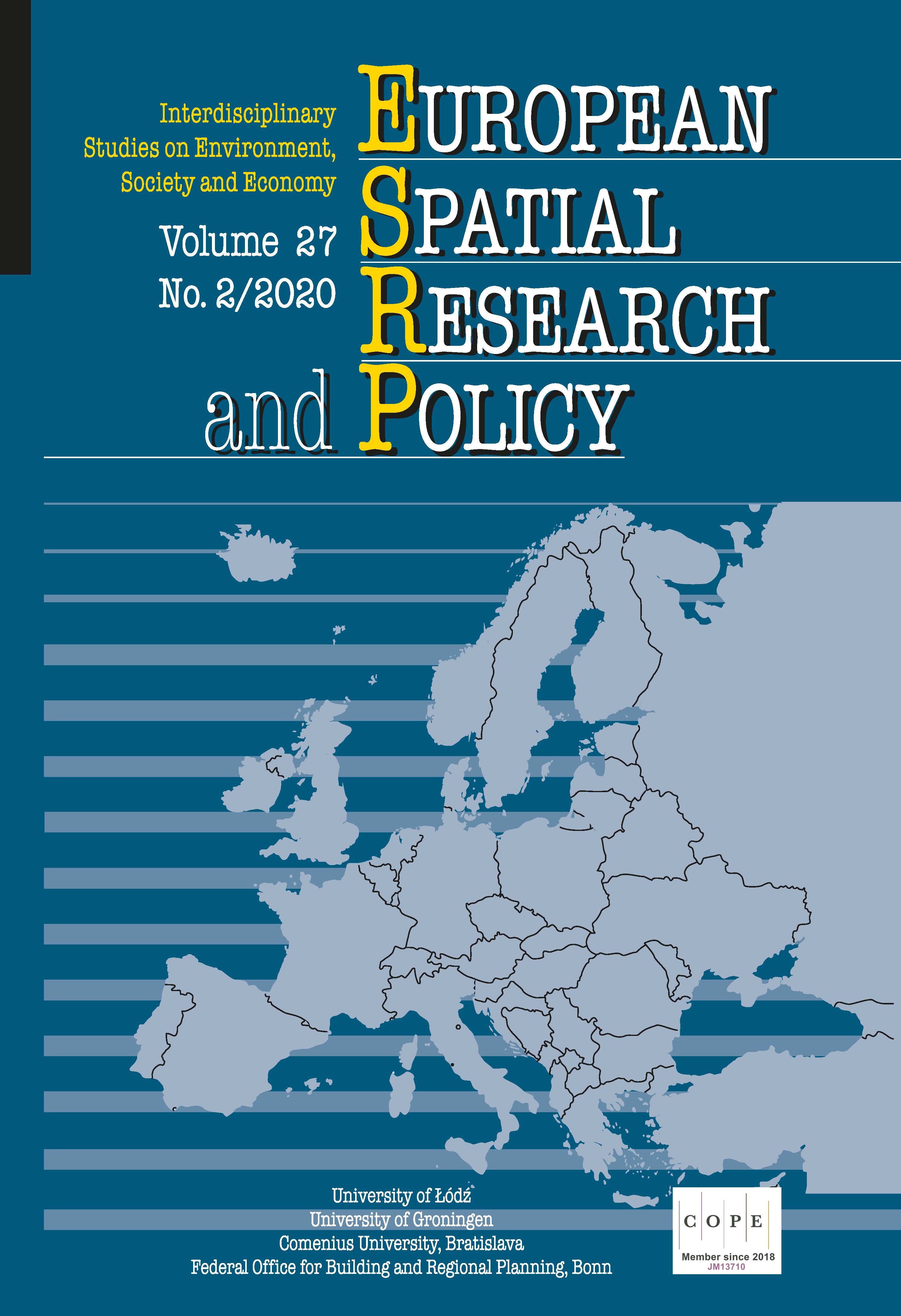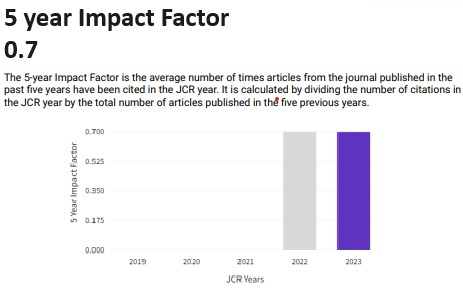The Influence of Land Cover on the Spatial Distribution of Fire Sites: A Case Study of Łódzkie Voivodeship, Poland
DOI:
https://doi.org/10.18778/1231-1952.27.2.11Keywords:
fire incident, GIS, land cover, fire high-risk area, fire location quotient, Łódzkie VoivodeshipAbstract
The paper continues from previous joint studies and their practical application at the confluence of human geography, safety-related research and Geographic Information Systems (GIS). The objective of the study was to identify the land cover types most at risk from fire. The study has contributed an original angle by taking into account various land cover types with a potential influence on the distribution of fires geocoded at the address level. The analysis considered 27,651 fire interventions, as recorded by the Polish State Fire Service between 2014 and 2016 in the country’s central region known as Łódzkie Voivodeship. The main methods employed include various GIS tools, including Voronoi tessellation (to identify the areas most at risk of fire) and the fire location quotient (FLQ, a measure of the colocation between the number of fires and land cover). The most important conclusion is that of all the land cover types considered in the study, the built-up area type, especially the multi-family residential and retail and service area subtypes, was virtually the only one with a strong influence on the location of fires. The fire high-risk areas (FH-RA) identified here were primarily limited to urban areas.
Downloads
References
AKAY, A.E. and ERDOĞAN, A. (2017), ‘Gis-Based Multi-Criteria Decision Analysis For Forest Fire Risk Mapping’, ISPRS Annals of the Photogrammetry, Remote Sensing and Spatial Information Sciences, IV-4/W4, pp. 25–30. https://doi.org/10.5194/isprs-annals-IV-4-W4-25-2017
Google Scholar
DOI: https://doi.org/10.5194/isprs-annals-IV-4-W4-25-2017
AKAY, A.E. and ŞAHIN, H.T. (2019), ‘Forest Fire Risk Mapping by using GIS Techniques and AHP Method: A Case Study in Bodrum (Turkey)’, European Journal of Forest Engineering, 5 (1), pp. 25–35. https://doi.org/10.33904/ejfe.579075
Google Scholar
DOI: https://doi.org/10.33904/ejfe.579075
ASGARY, A., GHAFFARIA, A. and LEVY, J. (2010), ‘Spatial and temporal analyses of structural fire incidents and their causes: A case of Toronto, Canada’, Fire Safety Journal, 45 (1), pp. 44–57. https://doi.org/10.1016/j.firesaf.2009.10.002
Google Scholar
DOI: https://doi.org/10.1016/j.firesaf.2009.10.002
BAJOCCO, S., PEZZATTI, G.B., MAZZOLENI, S. and RICOTTA, C. (2010), ‘Wildfire seasonality and land use: when do wildfires prefer to burn?’, Environmental Monitoring and Assessment, 164 (1–4), pp. 445–452. https://doi.org/10.1007/s10661-009-0905-x
Google Scholar
DOI: https://doi.org/10.1007/s10661-009-0905-x
CORCORAN, J., HIGGS, G., BRUNSDON, C., WARE, A. and NORMAN, P. (2007), ‘The use of spatial analytical techniques to explore patterns of fire incidence: A South Wales case study’, Computers, Environment and Urban Systems, 31 (6), pp. 623–647. https://doi.org/10.1016/j.compenvurbsys.2007.01.002
Google Scholar
DOI: https://doi.org/10.1016/j.compenvurbsys.2007.01.002
DLAMINI, W.M. (2011), ‘Application of Bayesian networks for fire risk mapping using GIS and remote sensing data’, GeoJournal, 76 (3), pp. 283–296. https://doi.org/10.1007/s10708-010-9362-x
Google Scholar
DOI: https://doi.org/10.1007/s10708-010-9362-x
ERDEN, T. and COŞKUN, M.Z. (2010), ‘Multi-criteria site selection for fire services: the interaction with analytic hierarchy process and geographic information systems’, Natural Hazards and Earth System Sciences, 10, pp. 2127–2134. https://doi.org/10.5194/nhess-10-2127-2010
Google Scholar
DOI: https://doi.org/10.5194/nhess-10-2127-2010
EUGENIO, F.C., dos SANTOS, A.R., FIEDLER, N.C., RIBEIRO, G.A., da SILVA, A.G., dos SANTOS, A.B., PANETO, G.G. and SCHETTINO, V.R. (2016), ‘Applying GIS to develop a model for forest fire risk: A case study in Espirito Santo, Brasil’, Journal of Environmental Management, 173, pp. 65–71. https://doi.org/10.1016/j.jenvman.2016.02.021
Google Scholar
DOI: https://doi.org/10.1016/j.jenvman.2016.02.021
FEURDEAN, A., VANNIÈRE, B., FINSINGER, W., WARREN, D., CONNOR, S.C., FORREST, M., LIAKKA, J., PANAIT, A., WERNER, C., ANDRIČ, M., BOBEK, P., CARTER, V.A., DAVIS, B., DIACONU, A.-C., DIETZE, E., FEESER, I., FLORESCU, G., GAŁKA, M., GIESECKE, T., JAHNS, S., JAMRICHOVÁ, E., KAJUKAŁO, K., KAPLAN, J., KARPIŃSKA-KOŁACZEK, M., KOŁACZEK, P., KUNEŠ, P., KUPRIYANOV, D., LAMENTOWICZ, M., LEMMEN, C., MAGYARI, E.K., MARCISZ, K., MARINOVA, E., NIAMIR, A., NOVENKO, E., OBREMSKA, M., PĘDZISZEWSKA, A., PFEIFFER, M., POSKA, A., RÖSCH, M., SŁOWIŃSKI, M., STANČIKAITĖ, M., SZAL, M., ŚWIĘTA-MUSZNICKA, J., TANŢĂU, I., THEUERKAUF, M., TONKOV, S., VALKÓ, O., VASSILJEV, J., VESKI, S., VINCZE, I., WACNIK, A., WIETHOLD, J. and HICKLER, T. (2020), ‘Fire hazard modulation by long-term dynamics in land cover and dominant forest type in Eastern and Central Europe’, Biogeosciences, 17, pp. 1213–1230. https://doi.org/10.5194/bg-17-1213-2020
Google Scholar
DOI: https://doi.org/10.5194/bg-17-1213-2020
Fire management: voluntary guidelines. Principles and strategic actions (2006), Rome: FAO. http://www.fao.org/3/j9255e/j9255e00.pdf [accessed on: 03.09.2020].
Google Scholar
GUO, F., SU, Z., TIGABU, M., YANG, X., LIN, F., LIANG, H. and WANG, G. (2017), ‘Spatial Modelling of Fire Drivers in Urban-Forest Ecosystems in China’, Forests, 8, p. 180.
Google Scholar
DOI: https://doi.org/10.3390/f8060180
HAAS, J.R., CALKIN, D.E. and THOMPSON, M.P. (2013), ‘A national approach for integrating wildfire simulation modeling into Wildland Urban Interface risk assessments within the United States’, Landscape and Urban Planning, 119, pp. 44–53. https://doi.org/10.1016/j.landurbplan.2013.06.011
Google Scholar
DOI: https://doi.org/10.1016/j.landurbplan.2013.06.011
HABIBI, K., LOTFI, S. and KOOHSARI, M.J. (2008), ‘Spatial Analysis of Urban Fire Station Location by Integrating AHP Model and IO Logic Using GIS (A Case Study of Zone 6 of Tehran)’, Journal of Applied Sciences, 8 (19), pp. 3302–3315. https://doi.org/10.3923/jas.2008.3302.3315
Google Scholar
DOI: https://doi.org/10.3923/jas.2008.3302.3315
HART, T. and ZANDBERGEN, P. (2014), ‘Kernel density estimation and hotspot mapping: Examining the influence of interpolation method, grid cell size, and bandwidth on crime forecasting’, Policing: An International Journal of Police Strategies & Management, 37 (2), pp. 305–323. https://doi.org/10.1108/PIJPSM-04-2013-0039
Google Scholar
DOI: https://doi.org/10.1108/PIJPSM-04-2013-0039
HASTIE, C. and SEARLE, R. (2016), ‘Socio-economic and demographic predictors of accidental dwelling fire rates’, Fire Safety Journal, 84, pp. 50–56. https://doi.org/10.1016/j.firesaf.2016.07.002
Google Scholar
DOI: https://doi.org/10.1016/j.firesaf.2016.07.002
HOLBORN, P.G., NOLAN, P.F. and GOLT, J. (2003), ‘An analysis of fatal unintentional dwelling fires investigated by London Fire Brigade between 1996 and 2000’, Fire Safety Journal, 38 (1), pp. 1–42. https://doi.org/10.1016/S0379-7112(02)00049-8
Google Scholar
DOI: https://doi.org/10.1016/S0379-7112(02)00049-8
HUANG, B., LIU, N. and CHANDRAMOULI, M. (2006), ‘A GIS supported Ant algorithm for the linear feature covering problem with distance constraints’, Decision Support Systems, 42 (2), pp. 1063–1075. https://doi.org/10.1016/j.dss.2005.09.002
Google Scholar
DOI: https://doi.org/10.1016/j.dss.2005.09.002
Information Bulletin Of The State Fire Service For The Year 2016 (2017). http://www.straz.gov.pl/download/4022 [accessed on: 15.03.2020].
Google Scholar
Instrukcja ochrony przeciwpożarowej lasu, (2020), Warszawa: Centrum Informacyjne Lasów Państwowych. http://www.lasy.gov.pl/pl/publikacje/copy_of_gospodarka-lesna/ochrona_lasu/instrukcja_p-poz.pdf [accessed on: 11.02.2020].
Google Scholar
ISARD, W., BRAMHALL, D.F., CARROTHERS, G.A.P., CUMBERLAND, J.H., MOSES, L.N., PRICE, D.O. and SCHOOLER, E.W. (eds.) (1962), Methods of Regional Analysis: An Introduction to Regional Science, Cambridge: M.I.T. Press.
Google Scholar
JAJTIĆ, K., GALIJAN, V., ŽAFRAN, I. and CVITANOVIĆ, M. (2019), ‘Analysing Wildfire Occurrence Through A Mixed-Method Approach: A Case Study From The Croatian Mediterranean’, Erdkunde, 73 (4), pp. 323–341. https://doi.org/10.3112/erdkunde.2019.04.05
Google Scholar
DOI: https://doi.org/10.3112/erdkunde.2019.04.05
JENNINGS, C.R. (2013), ‘Social and economic characteristics as determinants of residential fire risk in urban neighborhoods: A review of the literature’, Fire Safety Journal, 62, pp. 13–19. https://doi.org/10.1016/j.firesaf.2013.07.002
Google Scholar
DOI: https://doi.org/10.1016/j.firesaf.2013.07.002
KOSTRUBIEC, B. (1972), ‘Analiza zjawisk koncentracji w sieci osadniczej. Problemy metodyczne’, Prace Geograficzne, 93.
Google Scholar
KOZIOŁ, J. (2019), ‘Mapowanie rozkładu pożarów i miejscowych zagrożeń na przykładzie województwa mazowieckiego’, Safety & Fire Technology, 54 (2), pp. 22–31. https://doi.org/10.12845/sft.54.2.2019.2
Google Scholar
DOI: https://doi.org/10.12845/sft.54.2.2019.2
LEE, I. and LEE, K. (2009), ‘A generic triangle-based data structure of the complete set of higher order Voronoi diagrams for emergency management’, Computers, Environment and Urban Systems, 33, pp. 90–99. https://doi.org/10.1016/j.compenvurbsys.2009.01.002
Google Scholar
DOI: https://doi.org/10.1016/j.compenvurbsys.2009.01.002
LI, Y., ZHAO, J., GUO, X., ZHANG, Z., TAN, G. and YANG, J. (2017), ‘The Influence of Land Use on the Grassland Fire Occurrence in the Northeastern Inner Mongolia Autonomous Region, China’, Sensors, 17 (3), p. 437. https://doi.org/10.3390/s17030437
Google Scholar
DOI: https://doi.org/10.3390/s17030437
MAZUR, R. (2014), ‘Ocena stopnia bezpieczeństwa w aspekcie statystyk zdarzeń za lata 2000–2012. Czasowo-przestrzenna charakterystyka zagrożeń pożarowych obiektów mieszkalnych w systemie informacji przestrzennej (GIS) na przykładzie m.st. Warszawa’, BiTP. Bezpieczeństwo i Technika Pożarnicza, 34 (2), pp. 47–56.
Google Scholar
DOI: https://doi.org/10.12845/bitp.34.2.2014.4
MAZUR, R. and GUZEWSKI, P. (2014), ‘Ocena stopnia bezpieczeństwa w aspekcie statystyk zdarzeń za lata 2000-2012. Analiza statystyczna przypuszczalnych przyczyn pożarów obiektów mieszkalnych w skali kraju i miasta’, Bezpieczeństwo i Technika Pożarnicza, 35 (3), pp. 47–59.
Google Scholar
DOI: https://doi.org/10.12845/bitp.35.3.2014.5
MAZUR, R. and KWASIBORSKI, A. (2013), ‘Ocena stopnia bezpieczeństwa w aspekcie statystyk zdarzeń za lata 2007–2012. Pożary’, Bezpieczeństwo i Technika Pożarnicza, 30 (2), pp. 17–22.
Google Scholar
MAZUR, R., PAJĄK, M., KŁOSIŃSKI, M. and KLECHA, P. (2015), ‘Koncepcja budowy i zastosowania infrastruktury danych przestrzennych w aspekcie planowania operacyjnego Państwowej Straży Pożarnej. Studium przypadku na podstawie województwa świętokrzyskiego’, [in:] WRÓBLEWSKI, D. (ed.). Zarządzanie kryzysowe Wybrane wyniki badań naukowych i prac rozwojowych, Józefów: Centrum Naukowo-Badawcze Ochrony Przeciwpożarowej, Państwowy Instytut Badawczy, pp. 128–147.
Google Scholar
MOFFAT, A.J. and PEARCE, H.G. (2013), Harmonising approaches to evaluation of forest fire risk, A report by Forest Resarch & Scion, supported by Tranzfor, Farnham.
Google Scholar
NIMLYAT, P.S., AUDU, A.U., OLA-ADISA, E.O. and GWATAU, D. (2017), ‘An evaluation of fire safety measures in high-rise buildings in Nigeria’, Sustainable Cities and Society, 35, pp. 774– 785. https://doi.org/10.1016/j.scs.2017.08.035
Google Scholar
DOI: https://doi.org/10.1016/j.scs.2017.08.035
PAYSEN, T.E., ANSLEY, R.J., BROWN, J.K., GOTTFRIED, G.J., HAASE, S.M., HARRINGTON, M.G., NAROG, M.G., SACKETT, S.S. and WILSON, R.C. (2000), ‘Fire in western shrubland, woodland, and grassland ecosystems’, [in:] BROWN, J.K. and SMITH, J.K. (eds.), Wildland fire in ecosystems: effects of fire on flora, Fort Collins: U.S. Department of Agriculture, Forest Service, Rocky Mountain Research Station, pp. 121–159.
Google Scholar
Podręcznik Użytkownika Systemu SWD-ST 2.5 (2014). https://www.swdst.pl/wp-content/uploads/pliki/instrukcja_swd_st_2.5.pdf [accessed on: 15.03.2020].
Google Scholar
QIAO, Y., HUANG, K., JEUB, J., QIAN, J. and SONG, Y., (2018), ‘Deploying electric vehicle charging stations considering time cost and existing infrastructure’, Energies, 11, p. 2436. https://doi.org/10.3390/en11092436
Google Scholar
DOI: https://doi.org/10.3390/en11092436
Rozporządzenie Ministra Spraw Wewnętrznych i Administracji z dnia 18 lutego 2011 r. w sprawie szczegółowych zasad organizacji krajowego systemu ratowniczo-gaśniczego (Dz.U. 2011 nr 46, poz. 239).
Google Scholar
RUNGE, J. (2006), Metody badań w geografii społeczno-ekonomicznej – elementy metodologii, wybrane narzędzia badawcze, Katowice: Wydawnictwo Uniwersytetu Śląskiego.
Google Scholar
SCHAEFER, A.J. and MAGI, B.I. (2019), ‘Land-Cover Dependent Relationships between Fire and Soil Moisture’, Fire, 2, p. 55. https://doi.org/10.3390/fire2040055
Google Scholar
DOI: https://doi.org/10.3390/fire2040055
SCOTT, J.H., THOMPSON, M.P. and CALKIN, D.E. (2013), A wildfire risk assessment framework for land and resource management, Fort Collins: U.S. Department of Agriculture, Forest Service, Rocky Mountain Research Station. https://doi.org/10.2737/RMRS-GTR-315
Google Scholar
DOI: https://doi.org/10.2737/RMRS-GTR-315
SHAI, D. (2006), ‘Income, Housing, and Fire Injuries: A Census Tract Analysis’, Public Health Reports, 121 (2), pp. 149–154. https://doi.org/10.1177/003335490612100208
Google Scholar
DOI: https://doi.org/10.1177/003335490612100208
SUCHECKI, B. (2010), Ekonometria przestrzenna. Metody i modele analizy danych przestrzennych, Warsaw: Wydawnictwo C.H. Beck.
Google Scholar
SYPION-DUTKOWSKA, N. and LEITNER, M. (2017), ‘Land Use Influencing the Spatial Distribution of Urban Crime: A Case Study of Szczecin, Poland’, ISPRS International Journal of Geo-Information, 6 (3), pp. 74. https://doi.org/10.3390/ijgi6030074
Google Scholar
DOI: https://doi.org/10.3390/ijgi6030074
Ustawa z dnia 24 sierpnia 1991 r. o ochronie przeciwpożarowej (Dz.U. 1991 nr 81, poz. 351).
Google Scholar
VASILIAUSKAS, D. and BECONYTĖ, G. (2015), ‘Spatial analysis of fires in Vilnius city in 2010–2012’, Geodesy and Cartography, 41 (1), pp. 25–30. https://doi.org/10.3846/20296991.2015.1011862
Google Scholar
DOI: https://doi.org/10.3846/20296991.2015.1011862
WANG, J. and KWAN, M. (2018), ‘Hexagon-based adaptive crystal growth Voronoi diagrams based on weighted planes for service area delimitation’, ISPRS International Journal of Geo-Information, 7 (7), p. 257. https://doi.org/10.3390/ijgi7070257
Google Scholar
DOI: https://doi.org/10.3390/ijgi7070257
WOŹNIAK, E. (2014), ‘Określanie metodami geoinformatycznymi stopnia zagrożenia pożarowego lasów w Polsce’, Teledetekcja Środowiska, 51, pp. 5–55.
Google Scholar
XIA, Z., LI, H., CHEN, Y. and YU, W. (2019), ‘Detecting urban fire high-risk regions using colocation pattern measures’, Sustainable Cities and Society, 49, p. 101607. https://doi.org/10.1016/j.scs.2019.101607
Google Scholar
DOI: https://doi.org/10.1016/j.scs.2019.101607
YANG, L., JONES, B.F. and YANG, S. (2007), ‘A fuzzy multi-objective programming for optimization of fire station locations through genetic algorithms’, European Journal of Operational Research, 181 (2), pp. 903–915. https://doi.org/10.1016/j.ejor.2006.07.003
Google Scholar
DOI: https://doi.org/10.1016/j.ejor.2006.07.003
ZHANG, W. and JIANG, J.C. (2011), ‘Research on the location of fire station based on GIS and GA’, Applied Mechanics and Materials, 130–134, pp. 377–380. https://doi.org/10.4028/www.scientific.net/AMM.130-134.377
Google Scholar
DOI: https://doi.org/10.4028/www.scientific.net/AMM.130-134.377
ZHU, H.H., YAN, H.W. and LI, Y. (2008), ‘An optimization method for the layout of public service facilities based on Voronoi diagrams’, Science of Surveying and Mapping, 33, pp. 72–74.
Google Scholar
Downloads
Published
How to Cite
Issue
Section
License

This work is licensed under a Creative Commons Attribution-NonCommercial-NoDerivatives 4.0 International License.














